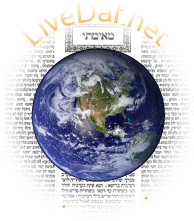It is common practice today to wear Tzitzis with a neck hole in the middle; why doesn’t the empty space on both sides nullify the material which is situated between them?
Tag Archives: parutz
Eruvin 10 – עירובין י
Click here to view text of Daf (can be minimized alongside player)
Play Audio Only Download Audio Download Video Diagram 1 Diagram 2 Diagram 3 Diagram 4 Diagram 5 Diagram 6
Today’s Daf Yomi Question:
It is common practice today to wear Tzitzis with a neck hole in the middle; why doesn’t the empty space on both sides nullify the material which is situated between them?
Eruvin 11 – עירובין יא
Although Rav doesn’t subscribe to a Tzuras Hapesach over ten amos for Shabbos, he agrees that it can be applied for Kilayim, as we see in the Braisa (amud beis – see Tosfos 6a). How can we explain the difference between Kilayim and Shabbos?
Eruvin 11- עירובין יא
Click here to view text of Daf (can be minimized alongside player)
Play Audio Only Download Audio Download Video Diagram 1 Diagram 2 Diagram 3
Today’s Daf Yomi Question:
Although Rav doesn’t subscribe to a Tzuras Hapesach over ten amos for Shabbos, he agrees that it can be applied for Kilayim, as we see in the Braisa (amud beis – see Tosfos 6a). How can we explain the difference between Kilayim and Shabbos?
Eruvin 14 – עירובין יד
According to the opinion that a Lechi functions based on the principle of mechitza, how can a Lechi be less than three tefachim which is generally considered Lavud?
Eruvin 14 – עירובין יד
Click here to view text of Daf (can be minimized alongside player)
Play Audio Only Download Audio Download Video Diagram 1 Diagram 2 Diagram 3
Today’s Daf Yomi Question:
According to the opinion that a Lechi functions based on the principle of mechitza, how can a Lechi be less than three tefachim which is generally considered Lavud?
Eruvin 16 – עירובין טז
Click here to view text of Daf (can be minimized alongside player)
Play Audio Only Download Audio Download Video Diagram 1 Diagram 2 Diagram 3 Diagram 4 Diagram 5 Diagram 6
Today’s Daf Yomi Question:
Abaye explains that the Rabanan agree that a ‘Makom Chashuv’ is only achieved with four tefachim; if so how can we explain that Lavud is set at three?
Tosfos writes, that although we conclude in the Gemara that half Omed half Parutz is fine, that won’t necessarily apply to other area such as issur or tuma, where half and half may not be sufficient – how can we explain this difference?
Eruvin 16 – עירובין טז
Abaye explains that the Rabanan agree that a ‘Makom Chashuv’ is only achieved with four tefachim; if so how can we explain that Lavud is set at three?
Tosfos writes, that although we conclude in the Gemara that half Omed half Parutz is fine, that won’t necessarily apply to other area such as issur or tuma, where half and half may not be sufficient – how can we explain this difference?
Succah 15 – סוכה טו
Insights on Today’s Daf
1) Shaking boards or reconstructing; an in depth analyses.
2) Parutz ke’omed: Rationale behind the Shabbos – Succah comparison.
3) How can sechach which is pasul be allowed to support kosher sechach?
Succah 15 – סוכה טו
Next day’s Daf Yomi now appears below Today’s Daf Yomi
Click here to view text of Daf (can be minimized alongside player)
Play Audio Only Download Audio Download Video Charts and Diagrams
Insights on Today’s Daf
1) Shaking boards or reconstructing; an in depth analyses.
2) Parutz ke’omed: Rationale behind the Shabbos – Succah comparison.
3) How can sechach which is pasul be allowed to support kosher sechach?
Next day’s Daf Yomi – Succah 16
Click here to view text of Daf (can be minimized alongside player)
Play Audio Only Download Audio Download Video Charts and Diagrams
